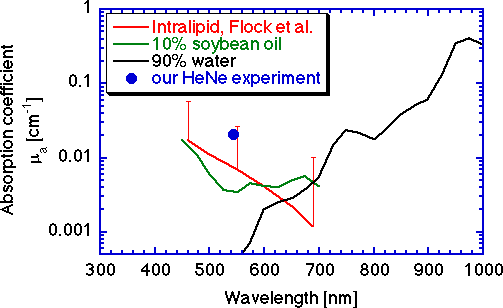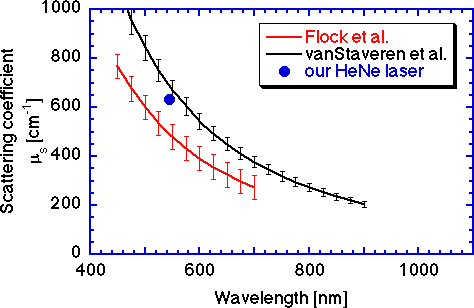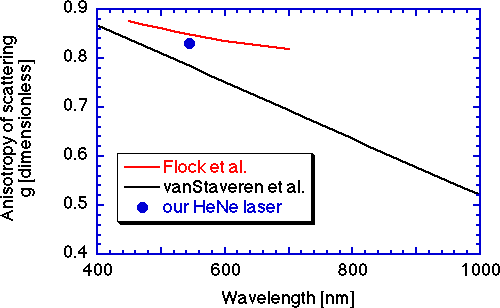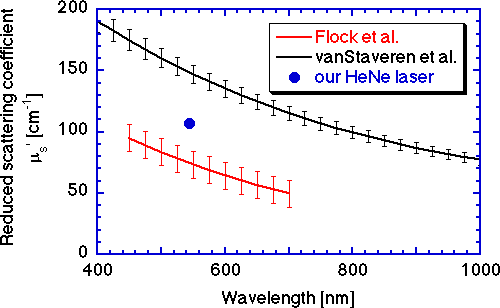Intralipid (Kabivitrum Inc., California and Stockholm) is a brandname for an aqueous suspension of lipid droplets that is sterile and suitable for intravenous feeding of patients. There are other brands (Nutralipid (Pharmicia, Quebec), Liposyn (Abbot Labs, Montreal)) which should be similar in composition. Available as Intralipid-10% and Intralipid-20% (10% lipid indicates 10 g of lipid per 100 ml of suspension). The constituents of Intralipid-10% in a 500 mL bottle according to the manufacturer are:
| Constituent | Mass | Volume |
| (g) | (mL) | |
| soybean oil | 50 | 53.94 |
| lecithin | 6 | 5.82 |
| glycerin | 11.25 | 8.92 |
| water | 430.5 | 431.33 |
| TOTAL | 497.75 | 500 |
Intralipid is used for intravenous feeding of patients. Used in the biomedical optics community as a scattering medium for phantoms that mimic turbid tissues when conducting optical experiments.
There is sufficient bottle-to-bottle variation in the optical properties of commercially available Intralipid, or other brandname products, that optical properties should be verified experimentally for each bottle at the time of use. Therefore, the properties reported here are simply approximate.
The optical properties of lipid suspensions in water is from:
- Ref. 1: ST Flock, SL Jacques, BC. Wilson, WM Star, MJC van Gemert, "Optical Properties of Intralipid: A phantom medium for light propagation studies," Lasers in Surgery and Medicine 12:510-519, 1992.
- Ref. 2: HG van Staveren, CJM Moes, J van Marle, SA Prahl, MJC van Gemert, "Light scattering in Intralipid-10% in the wavelength range of 400-1100 nanometers," Applied Optics 30:4507-4514, 1991.
The determination of optical properties by Flock et al. and in our HeNe laser experiment were based on diffuse reflectance measurements on Intralipid-10% with and without added absorber. Total attenuation of collimated light was measured. Details of these experimental procedures.
The determination of optical properties by van Staveren et al. was based on experimental measurements of light diffusion within Intralipid-10% with and without added absorber. Total attenuation of collimated light was measured. In addition, Mie theory calculations of anisotropy, g, based on lipid droplet size distributions determined by experimental freeze fracture and electron microscopy, were shown to closely agree with the experiments. This summary cites their simple expressions which approximate the Mie theory solutions.
The absorption coefficient

For comparison, 10% of the absorption of pure soybean oil is shown, and 90% of the absorption of pure water is shown. The water data of Hale and Querry, Applied Optics 12:555-563, 1973, was multiplied by 0.90. The error bars (standard deviations) of the intralipid are quite large, but the results show that the approximate absorption of 10% Intralipid is probably well approximated by the combination of 10% soybean oil and 90% water. The solid blue circle is our recent HeNe laser experiment.
The scattering coefficient

The spectrum of Flock et al. (red line) is approximated:
μs = (1.17 x 109)(nm-2.33) [cm-1].
The Mie theory approximation (black line, van Staveren et al.) is:
μs = (2.54 x 109)(nm-2.4) [cm-1]
Blue solid circle is our recent HeNe laser experiment.
The scattering anisotropy

The spectrum of Flock et al. is approximated:
g = 2.25(nm)-0.155
The Mie theory approximation (black line, van Staveren et al.) is:
g = 1.1 - (0.58 x 10-3)(nm)
In both expressions, nm is the wavelength expressed in nanometers. Blue solid circle is our recent HeNe laser experiment.
The reduced scattering coefficient

μs' = μs(1 - g) [cm-1]
Conclusions
In summary, the variations between the data of Flock, van Staveren, and our recent HeNe experiment may indicate the variation in the batches of Intralipid used. Other data from various investigators cited in Flock et al. (Table 1 and Fig. 7 of that paper) show a range of values for μs and g that vary between the Flock and van Staveren data summarized here. One should document the optical properties of the batch of Intralipid to be used in an experiment, and one should be confident of the measurement techniques used for such documentation.